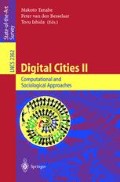Abstract
With the goal of studying online community, we created two multi-user virtual environment products [1], Microsoft V-Chat [2] in 1996, and the Virtual Worlds Platform [3] in 1998. We analyzed the social interaction that developed in these virtual environments and were particularly interested in better understanding what factors contribute to sustaining online community. Drawing from the design and evolution of physical cities [4] we believed an online community must be able to change over time and evolve the space within a flexible infrastructure. Over the past six years we have learned a number of lessons about the design of community and the effects of design.
Access this chapter
Tax calculation will be finalised at checkout
Purchases are for personal use only
Preview
Unable to display preview. Download preview PDF.
References
Virtual Worlds Group/Social Computing Group, Microsoft Research, Microsoft Corporation, http://research.microsoft.com/scg/.
The Microsoft V-Chat software (1995), produced by Microsoft Corp., Redmond WA.
The Virtual Worlds Platform software (1999), produced by Microsoft Corp., Redmond WA, http://vworlds.org/.
Bacon, E. (1976) The Design of Cities, New York: Random House.
Vellon, M., Marple, K., Mitchell, D., Drucker, S. (1998) The Architecture of a Distributed Virtual Worlds System. Unpublished report for Microsoft Research.
Reid, E. (1994) Cultural Formations in Text-Based Virtual Realities. Masters Thesis. English Department. University of Melbourne.
Morningstar, C., Farmer, R., (1991) The Lessons of Lucasfilm’s Habitat. In Benedikt, M. (Ed) Cyberspace: First Steps, Cambridge MA: MIT Press, pp. 273–302.
The Yorb project (1994), produced by O’Sullivan, D., New York University, NY.
Oldenberg, R. (1989) The Great Good Place, New York: Paragon House.
The Microsoft Network v1.0 software (1995), produced by Microsoft Corp., Redmond WA.
The Zora project (1999), produced by Bers, Marina U., MIT Media Lab, Cambridge, MA http://lcs.www.media.mit.edu/~marinau/Zora/.
Bers, M., Gonzalez-Heydrich, G., DeMaso, D. (2001) Identity Construction Environments: Supporting a Virtual Therapeutic Community of Pediatric Patients undergoing Dialysis. Proceedings of Computer-Human Interaction, ACM Press, pp. 380–387.
Bers, M. (1999) Zora: a Graphical Multi-user Environment to Share Stories about the Self. Proceedings of Computer Support for Collaborative Learning, ACM Press, pp. 33–40.
Cheng, L., Stone, L., Farnham, S., Clark, A. M., and Zaner-Godsey, M. (2000) Hutchworld: Lessons Learned. A Collaborative Project: Fred Hutchinson Cancer Research Center & Microsoft Research. Proceedings of Virtual Worlds Conference 2000, Paris, France, pp. 12–23.
The Fred Hutchinson Cancer Research Center, Seattle WA http://www.fhcrc.org/.
Kollock, P., University of California, Los Angeles. http://www.sscnet.ucla.edu/soc/faculty/kollock.
Smith, M., Microsoft Research, Redmond WA. http://research.microsoft.com/~masmith/.
Kollock, P. and Smith M. (1996) An Ethnography of MSN V-Chat, Unpublished report for Microsoft Corp., Redmond WA.
Smith, M. and Kollock P. (1998) What do People do in Virtual Worlds? An Analysis of V-Chat Log File Data, Unpublished report for Microsoft Corp., Redmond WA.
Barnett, T. (1996) V-Chat surveys and V-Chat Analysis, Unpublished report for Microsoft Corp., Redmond WA.
The ICQ software (1996), produced by Mirabilis Ltd. http://web.icq.com.
MSN Communities. http://communities.msn.com/home, 2001.
Yahoo Clubs. http://dir.clubs.yahoo.com/clubhouse, 2001.
AOL Groups. http://groups.aol.com/, 2001.
Farnham, S. (2001) Unpublished report, Microsoft Research.
Smith, M., Farnham, S., and Drucker S. (2000) The Social Life of Small Graphical Chat Spaces. Proceedings of CHI, ACM Press, pp. 462–469
Author information
Authors and Affiliations
Editor information
Editors and Affiliations
Rights and permissions
Copyright information
© 2002 Springer-Verlag Berlin Heidelberg
About this paper
Cite this paper
Cheng, L., Farnham, S., Stone, L. (2002). Lessons Learned: Social Interaction in Virtual Environments. In: Tanabe, M., van den Besselaar, P., Ishida, T. (eds) Digital Cities II: Computational and Sociological Approaches. Digital Cities 2001. Lecture Notes in Computer Science, vol 2362. Springer, Berlin, Heidelberg. https://doi.org/10.1007/3-540-45636-8_16
Download citation
DOI: https://doi.org/10.1007/3-540-45636-8_16
Published:
Publisher Name: Springer, Berlin, Heidelberg
Print ISBN: 978-3-540-43963-9
Online ISBN: 978-3-540-45636-0
eBook Packages: Springer Book Archive

